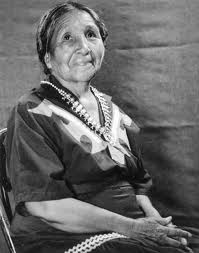Viola Jimulla facts for kids
Quick facts for kids
Viola Jimulla
|
|
|---|---|
| Sica-tuva, "Born Quickly," Who-wah, "Singing Cricket", Ka-hava-soo-ah, "Turquoise Bead in Nose" | |

Jimulla circa 1960
|
|
| Prescott Yavapai chair | |
| Preceded by | Sam "Red Ants" Jimulla |
| Succeeded by | Grace Mitchell and Lucy Miller |
| Personal details | |
| Born | 1878 San Carlos Apache Indian Reservation |
| Died | 1966 (aged 87–88) |
| Spouse | Sam "Red Ants" Jimulla |
| Children | Daughters: Daisy (1902-1902) Grace (Mrs. Don) Mitchell (1902-1976) Lucy (Mrs. Jim) Miller (1906-1984) Amy Vaughn Gazzam (1912-1940) and Rosie (1913-1914) She also raised her grandchildren: Patricia (Vaughn) McGee (1926-1994) and Theodore M. Vaughn (1928-2012) |
| Parents | Stepfather, Mr. Phelhame |
Viola Jimulla (1878 – December 7, 1966) was an important leader of the Yavapai-Prescott Tribe. She became the Chief of her tribe in 1940 after her husband, who was also a Chief, passed away. She continued to lead her people until her own death. Viola Jimulla was well-known for making life better for her tribe members and for her work with the Presbyterian Church.
Viola Jimulla's Early Life
Viola Jimulla was born in 1878. Her birthplace was the San Carlos Apache Indian Reservation. Her parents gave her the name Sica-tuva, which means "Born Quickly." Her mother's name was Who-wah, or "Singing Cricket." Her father's name was Ka-hava-soo-ah, meaning "Turquoise Bead in Nose."
When Viola went to school, she chose the name Viola. She used her stepfather's last name, Phelhame. She attended both the Rice Indian School and the Phoenix Indian School.
In 1900, Viola moved to live with her family near Prescott, Arizona. In 1901, she married Sam "Red Ants" Jimulla. They started a family together. Viola became a very active part of both the tribal community and the larger Prescott area.
Viola added her own energy to her husband's calm leadership. She was good at working with both Native American and Anglo (non-Native American) cultures. This skill helped her tribe and the Prescott area for many years.
In 1935, the Jimullas worked with local and national leaders. They helped set aside 75 acres (about 30 hectares) of land. This land became the Prescott-Yavapai Indian Reservation. In the 1950s, the reservation grew much larger. It became 1,327 acres (about 5.37 square kilometers).
In the same year, Sam was chosen as chief of the Prescott Yavapais. The Commissioner of Indian Affairs appointed him. Later, the tribe officially elected him as their chief.
Leading Her People
Sam Jimulla died in an accident in 1940. After his death, Viola became the Chieftess of the Prescott Yavapai Native American tribe. She led her tribe for 26 years. She guided them with great wisdom and kindness until her death on December 7, 1966.
Under Viola's leadership, the Yavapais achieved better living conditions. They also gained more modern facilities than many other tribes.
Viola Jimulla was strong and skilled. These qualities helped her people adapt and grow. They learned to live well with the surrounding Anglo community. Even though she connected the two cultures, she always respected her tribe's traditions.
Viola Jimulla was not only a great tribal leader. She also played an important role in religious matters. She was the first Yavapai person to be baptized into the Presbyterian Church.
In 1922, she and other tribe members helped restart the Yavapai Indian Mission. It became the Presbyterian Mission. Jimulla served the mission in many ways. She was an elder, a Sunday School superintendent, and an interpreter.
In 1950, she became a commissioner. This meant she represented her church at a big meeting. It was the General Assembly of the United Presbyterian Church in Cincinnati. There, she gave a speech about the mission. In 1951, the mission became an organized church. Later, in 1957, it was renamed the Trinity Presbyterian Church. This new name recognized the three groups that founded it. These were the new Presbyterians in Prescott, the original church, and the Presbyterian Indian people.
Under Jimulla’s leadership, the Prescott Yavapai Tribal Council was created. This council helped make sure the people's voices were heard in their own government.
Viola Jimulla's family continued to lead her people. Two of her daughters, Grace Mitchell and Lucy Miller, became chieftesses after their mother passed away. In 1986, Viola was honored. She was elected to the Arizona Women’s Hall of Fame.
There is a statue of Viola in Prescott. It shows her teaching basketry to a young Yavapai girl. This statue is in the lobby of the Prescott Resort and Conference Center. The young girl in the statue is her granddaughter, Patricia McGee. Patricia later became tribal president in 1972.

